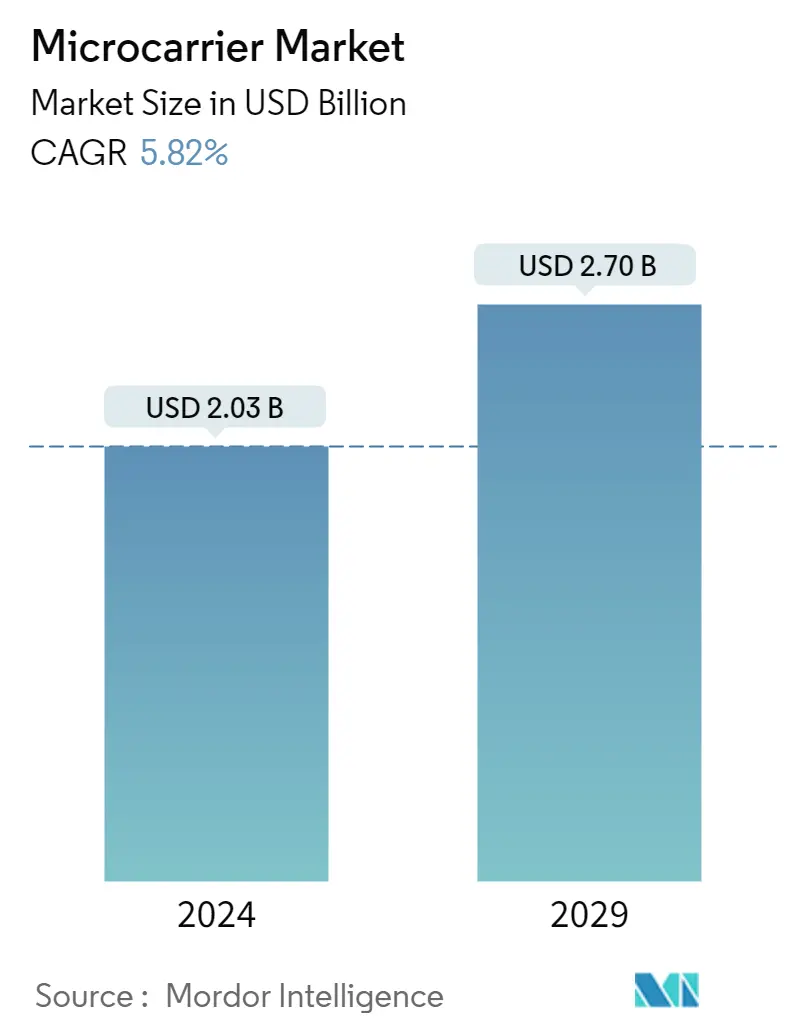Market Size of Microcarrier Industry

| Study Period | 2019 - 2029 |
| Market Size (2024) | USD 2.03 Billion |
| Market Size (2029) | USD 2.70 Billion |
| CAGR (2024 - 2029) | 5.82 % |
| Fastest Growing Market | North America |
| Largest Market | Asia Pacific |
Major Players
*Disclaimer: Major Players sorted in no particular order |
Microcarrier Market Analysis
The Microcarrier Market size is estimated at USD 2.03 billion in 2024, and is expected to reach USD 2.70 billion by 2029, growing at a CAGR of 5.82% during the forecast period (2024-2029).
The microcarrier market is majorly driven by factors such as rising demand for cell-based vaccines and therapeutics, the rapid growth of biologics and biosimilar industry, and increasing R&D and availability of funding for cell therapy research.
Many of the current biologics in the pipeline are targeting the indications, which are small-molecule dominated and have a large patient pool. This represents that in the forecast period the trend of biologics could enter several of the non-traditional biologic disease areas, which could benefit from the increased therapeutic efficacy. Furthermore, this is also providing the room to the biosimilar market to grow.
In terms of medical efficacy, therapeutic spread, and population access biopharmaceuticals have vast potential, and much of this potential is still untapped. This potential can gradually be realized as manufacturing technologies, such as microcarrier based synthesis make progress, which may lead to commercialization of more effective therapies, increased manufacturing efficacy, and reduced therapy costs. Hence, owing to such rapid growth of the biologics and biosimilar industry, the market is positively affected.
Microcarrier Industry Segmentation
A microcarrier is a support matrix, which allows the growth of adherent cells in bioreactors. In the large-scale commercial production of biologics and vaccines, microcarriers are employed to grow virus-generating or protein-producing adherent cell populations. As per the scope of the report, the microcarrier market includes various equipment and consumables, such as bioreactors, reagents, cell counters, and culture vessels in addition to microcarrier beads.
| By Material Type | |
| Alginate-Based | |
| Collagen-Based | |
| Dextran-Based | |
| Polystyrene-Based | |
| Others |
| By Application | |
| Cell Therapy | |
| Vaccine Manufacturing | |
| Other Applications |
| Geography | ||||||||
| ||||||||
| ||||||||
| ||||||||
| ||||||||
|
Microcarrier Market Size Summary
The microcarrier market is poised for significant growth, driven by the increasing demand for cell-based vaccines and therapeutics, alongside the rapid expansion of the biologics and biosimilar industry. This growth is further supported by heightened research and development activities and the availability of funding for cell therapy research. The market is witnessing a shift as biologics begin to target non-traditional disease areas, enhancing therapeutic efficacy and expanding the biosimilar market. Microcarriers play a crucial role in this landscape by facilitating cost-effective cell production, which is essential for large-scale manufacturing. Technological advancements, such as the development of dissolvable microcarriers, are enhancing the efficiency of cell therapy applications, thereby reducing production costs and streamlining downstream processes.
North America is expected to hold the largest share of the microcarrier market, driven by robust gene and cell therapy research and supportive associations like the American Society of Gene and Cell Therapy. The region's growth is further bolstered by the rapid advancement of the biologics and biosimilar industry, particularly in the United States. The market is characterized by the presence of global players such as Thermo Fisher Scientific, Sartorius AG, Eppendorf AG, Danaher Corporation, and Merck KGaA, with increasing competition as new entrants emerge. These companies are focusing on providing microcarriers that enable large-scale and cost-effective production, which is crucial for the continued expansion of cell therapy applications.
Microcarrier Market Size - Table of Contents
-
1. MARKET DYNAMICS
-
1.1 Market Overview
-
1.2 Market Drivers
-
1.2.1 Rising Demand for Cell-based Vaccines and Therapeutics
-
1.2.2 Rapid Growth of Biologics and Biosimilar Industry
-
1.2.3 Increasing R&D and Availability of Funding for Cell Therapy Research
-
-
1.3 Market Restraints
-
1.3.1 High Cost of Biologics and Cell-based Therapies
-
1.3.2 Possible Drawbacks of Microcarrier Cultures
-
-
1.4 Porter's Five Force Analysis
-
1.4.1 Threat of New Entrants
-
1.4.2 Bargaining Power of Buyers/Consumers
-
1.4.3 Bargaining Power of Suppliers
-
1.4.4 Threat of Substitute Products
-
1.4.5 Intensity of Competitive Rivalry
-
-
-
2. MARKET SEGMENTATION
-
2.1 By Material Type
-
2.1.1 Alginate-Based
-
2.1.2 Collagen-Based
-
2.1.3 Dextran-Based
-
2.1.4 Polystyrene-Based
-
2.1.5 Others
-
-
2.2 By Application
-
2.2.1 Cell Therapy
-
2.2.2 Vaccine Manufacturing
-
2.2.3 Other Applications
-
-
2.3 Geography
-
2.3.1 North America
-
2.3.1.1 United States
-
2.3.1.2 Canada
-
2.3.1.3 Mexico
-
-
2.3.2 Europe
-
2.3.2.1 Germany
-
2.3.2.2 United Kingdom
-
2.3.2.3 France
-
2.3.2.4 Italy
-
2.3.2.5 Spain
-
2.3.2.6 Rest of Europe
-
-
2.3.3 Asia-Pacific
-
2.3.3.1 China
-
2.3.3.2 Japan
-
2.3.3.3 India
-
2.3.3.4 Australia
-
2.3.3.5 South Korea
-
2.3.3.6 Rest of Asia-Pacific
-
-
2.3.4 Middle East and Africa
-
2.3.4.1 GCC
-
2.3.4.2 South Africa
-
2.3.4.3 Rest of Middle East and Africa
-
-
2.3.5 South America
-
2.3.5.1 Brazil
-
2.3.5.2 Argentina
-
2.3.5.3 Rest of South America
-
-
-
Microcarrier Market Size FAQs
How big is the Microcarrier Market?
The Microcarrier Market size is expected to reach USD 2.03 billion in 2024 and grow at a CAGR of 5.82% to reach USD 2.70 billion by 2029.
What is the current Microcarrier Market size?
In 2024, the Microcarrier Market size is expected to reach USD 2.03 billion.

